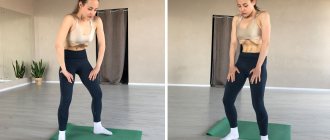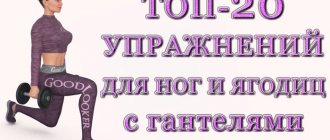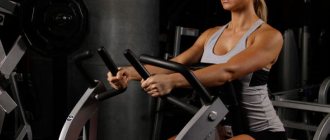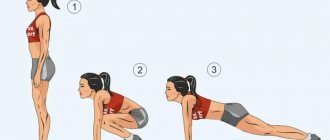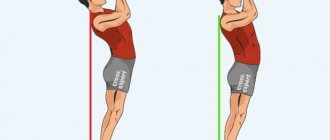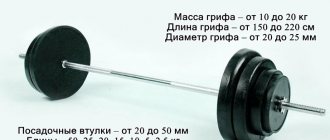A vacuum for the abdomen is a special yoga exercise that helps increase the tone of the transverse muscles. The benefit of this effective exercise is that it promotes weight loss and reduces your waistline. Do the exercise as often as possible (at least 5 times a week) and in just 21 days your figure will become slimmer and your abdominal shape will improve significantly. The transverse abdominis muscle is a natural "athletic belt". In untrained people, the transverse muscle is stretched, weak, and as a result the stomach “hangs.” The correct “vacuum” technique gives the transverse abdominal muscle elasticity and tone.
A LITTLE HISTORY. The exercise was invented by bodybuilders for a toned torso and straightened posture. As a rule, abdominal vacuum was actively practiced by performing athletes before competitions. The most famous example is Arnold Schwarzenegger.
Interesting facts about exercise
“Vacuum” comes from yoga: there it is known as “uddiyana bandha”, or “abdominal lock”. Initially, the exercise was created in order to eliminate problems with the gastrointestinal tract. Then it was noticed that the “vacuum” greatly pumps the transverse abdominal muscle, creating a kind of muscle corset and allowing you to achieve a beautiful relief and thin waist. The exercise gained particular popularity thanks to Arnold Schwarzenegger’s book “The New Encyclopedia of Bodybuilding.” Nowadays the “vacuum” technique is used in fitness, Pilates and other areas of physical activity. It is the pumping of the transverse muscle that allows you to strengthen the peritoneum and spine, has a beneficial effect on the female reproductive system and can even facilitate the process of childbirth (of course, if the expectant mother played sports before pregnancy). And the “vacuum” exercise for the abdomen can help get rid of excessive volumes: after all, this is the area that often remains problematic even in thin people.
How is a vacuum useful?
Training the transverse abdominal muscles is useful not only from an aesthetic point of view. A vacuum will help improve physical health and put the body in order.
Anastasia:
The transverse abdominis muscle belongs to the internal block along with the pelvic floor muscles, the diaphragm and the multifidus muscles of the back. And therefore, if it is not functional, this can provoke asynchronous ineffective work of all the above muscles and, as a result, cause back pain, poor posture, problems with the gastrointestinal tract and genitourinary system.
Photo: unsplash.com/@justdushawn
Regular vacuum performance:
- tightens the stomach;
- improves the functioning of the gastrointestinal tract;
- relieves tension from the lower back;
- prevents problems of the genitourinary system;
- improves blood circulation in the abdominal cavity and the functioning of all internal organs;
- prevents stagnation in the body.
Positive effect on the body
“Vacuum” would not have become so popular if it did not have a number of advantages. Among them:
- removing excessive stress from the lower back;
- improved blood circulation;
- fight against stagnation.
Regular exercise can help remove a bulging belly, make muscles more toned and reduce gastrointestinal problems. At the same time, the “vacuum” does not require any additional preparations, and it can be done lying down, standing or sitting. At an advanced level, you can perform this popular yoga asana even at work or in transport. So the exercise can be considered an ideal solution for those who want to achieve quick results and at the same time do not want to spend a lot of time doing tedious approaches and repetitions on machines in the gym.
Recommendations
- From the above-mentioned program, you can see that vacuum alone is not enough to lose weight and additional exercises must be included in the program, for example, cardio and other abdominal exercises. Read more about exercises for losing weight on your abs →
- Train for at least 30-40 minutes, perform loads every other day.
- You can also incorporate a vacuum into your strength training by performing the exercise at the end before the cool-down.
Who is it suitable for?
The “vacuum” exercise can be performed by women and men who want to strengthen their abdominal muscles and restore health to their internal organs. The asana is suitable even for children, but you should proceed with caution and be sure to consult a specialist before allowing your child to perform this exercise. The optimal age to start practicing “vacuum” is 16–18 years old, when the internal organs have long been formed and are sufficiently strong. In addition, the exercise is suitable for those who want to lose excess weight faster. In this case, it will have to be combined with aerobic and anaerobic exercise: the “vacuum” will strengthen the abs, but will not help you lose a few kilograms. Thus, the “vacuum” can be included in the set of exercises necessary for rapid weight loss. Or resort to it after losing weight to create a beautiful figure: a personal trainer will help you choose the ideal program.
What effects can be expected and what will not happen?
The vacuum can help tighten the belly and improve digestion.
However, people react differently to the exercise. Some people report feeling more alert or relieved from bloating. Others are discomfort and unpleasant sensations before and after execution. In case of discomfort, there is no need to perform the exercise.
A vacuum will not help you lose weight, get ripped abs, or cure diseases. But, like other exercises, it has its own beneficial effects, which is why it is popular in training programs.
Who should not perform a “vacuum”?
All asanas have contraindications, and “uddiyana bandha” was no exception. This exercise should not be done if you have:
- gastritis or duodenal ulcer;
- cholecystitis in the acute stage or pancreatitis;
- diseases of the biliary tract;
- colitis;
- dysbacteriosis;
- heart failure;
- chronic diseases of the abdominal and pelvic areas;
- menstruation;
- pregnancy;
- rehabilitation period after surgery in the abdomen or pelvis.
It is important! No exercise should be performed on a full stomach: at least an hour and a half should pass since the last meal!
If you have any disease not listed in the list of contraindications, we recommend that you first consult with your doctor in order to prevent possible negative consequences of using the vacuum technique. This is especially true for women with disorders of the genitourinary system.
What happens during a vacuum run?
Vacuum is an exercise that trains the inspiratory muscles and gently massages the gastrointestinal tract.
The mechanics of the exercise are as follows. After a smooth and deep inhalation, a full exhalation and breath holding follow. At this time, a “false inhalation” occurs: the diaphragm relaxes and retracts upward, the pressure in the abdominal cavity drops. As a result, the abdominal organs are also pulled up, and venous outflow improves.
The vacuum activates the parasympathetic nervous system, and therefore the digestive system: blood flow to the gastrointestinal tract increases, digestion processes and intestinal motility are stimulated.
How to lose weight faster?
If you have planned a full-fledged weight loss program in which you want to use a “vacuum”, it is best to start preparing in advance. Firstly, for all its effectiveness, this exercise is not able to completely get rid of fat deposits in the waist area. Secondly, it effectively works the abdominals, and not all muscles, so for quick results you will need:
- maintain water-salt balance. You need to drink at least one and a half liters of clean water per day;
- monitor your diet. Avoid fast food, store-bought sweets, carbonated drinks and juices. Eat fresh vegetables, dairy products, and protein daily. If you don't eat meat or don't eat enough of it, Herbalife Nutrition's Formula 1 shake can help replenish your protein reserves;
- to refuse from bad habits. Alcohol and cigarettes are the worst enemy of health and a beautiful figure.
Contraindications
Since losing weight using a vacuum involves working with deep abdominal muscles, visceral fat and affects the functioning of vital organs, it is not available to everyone.
Absolute contraindications:
- pregnancy;
- recent cesarean section or any other abdominal surgery;
- respiratory and cardiovascular diseases;
- problems with the gastrointestinal tract;
- menstruation;
- obesity;
- abdominal pain of any nature and origin;
- elevated body temperature, acute illness;
- neoplasms and inflammatory processes in the pelvic area and peritoneum;
- pathologies of the biliary tract.
A relative contraindication is the postpartum period. First, you need to wait for the lochia to stop and consult with the supervising gynecologist whether it is possible to begin such serious training. This precaution is due to the fact that powerful vacuum breathing stimulates the uterus and can slow down its recovery after childbirth.
Exercise technique for beginners
How to make a “vacuum” without harm to health? Start with the basics. A simple technique has been developed for beginners. You need to do the exercise while lying down. To do this, we recommend purchasing a gymnastics mat.
- Lie on your back, straighten your back and shoulders, press your lower back firmly to the floor, keep your arms along your body.
- Bend your knees slightly, placing your feet on the floor.
- Inhale slowly and deeply through your nose.
- Start exhaling through your mouth, trying to completely get rid of the air in your lungs.
- Tighten your abdominal muscles and pull it inward, as if wrapping it under your ribs.
- Stay in this position for 10–15 seconds.
- Begin to slowly relax and inhale smoothly.
- Take a few deep breaths and exhales, then repeat the exercise several times.
Gradually you will be able to hold your breath for a longer period of time. The optimal time to complete one approach is a minute.
All about abdominal vacuum and nauli: what are the benefits and video on how to do it correctly
If you have never heard of a vacuum, then you don’t have an Instagram page. The exercise “for a flat stomach” was demonstrated by, it seems, all more or less fit influencers. But there are nuances in performing seemingly simple movements. The editors of BeautyHack.ru asked various specialists all the questions that had arisen and recorded detailed video instructions: where to start and how to eventually achieve masterful use of nauli.
The main thing why bloggers love the belly vacuum is that it removes the protruding belly. But coach Anna Balobanova warns:
Anna Balobanova
Personal trainer at Elastic boutique studio
— Before removing a protruding belly, you need to figure out why it is protruding. This may occur due to prolapse of internal organs, uncoordinated muscle function, the presence of a layer of fatty tissue, and, ultimately, incorrect posture. Therefore, to say that a vacuum will help make your stomach flat is simply illiterate. But it can be one of the tools to achieve the goal. This exercise helps to better control the abdominal muscles and improves intestinal motility. And in combination with correctly and individually selected nutrition and training, with a healthy gastrointestinal tract - yes, there will be an effect. But with all the reservations.
At the same time, it is worth understanding that the vacuum of the abdomen does not pump the muscles: it is work through breathing. In simple terms, the task is to tighten the lower diaphragm; this is an internal job. The diaphragm contracts, the stomach retracts, but this does not burn the fat and does not strain the muscle. But you will learn to feel and control it, which will help in the exercises. One vacuum will definitely not remove the stomach.
EncoreFitness trainer Vadim Guryev adds: the effectiveness of the “vacuum” directly depends on how a person performs it.
Vadim Guryev
elite trainer Encore Fitness
The spine should be as close as possible to a neutral position - a round back or excessive arching will only harm the body by disrupting breathing mechanisms, squeezing blood vessels and disrupting the blood supply to the pelvic organs. When performed correctly, “vacuum” is a necessary and useful exercise that makes it possible to stabilize the lumbar region during strength exercises; it has a good effect on the pelvic floor muscles.
The benefits of abdominal vacuum and whether everyone needs to be able to do Nauli
Now let's figure out how to do a stomach vacuum correctly. Since the practice originally came out of yoga, we asked to talk about the original meaning and show the technique of performing the teacher of Jivamukti Yoga and the founder of the yoga studio “Material” Anna Lunegova. Nauli is a skill for advanced people. It’s better to start with two yogic techniques - Uddiyana Badha and Agnisara Kriya.
Anna Lunegova
Jivamukti yoga teacher and founder of the yoga studio “Material”
— Nauli is the most important of the practices of Hatha Yoga. It involves circular manipulation of the abdominal muscles, creating a dynamic massage of the internal organs (small and large intestines). This practice improves the functioning of the liver, pelvic organs, and improves blood circulation. It also makes breathing deep and smooth and, therefore, affects the functioning of the brain.
Nauli is an intense practice and requires levels of training. It’s better to start with two yogic techniques - Uddiyana Bandha and Agnisara Dhauti Kriya
Contraindications
Nauli, Uddiyana Badha and Agnisara Kriya have contraindications: the female cycle and several days before and after it, exacerbation of diseases associated with the digestive system, high blood pressure, umbilical hernia.
When to do it
It is better to perform these techniques in the morning on an empty stomach, after drinking a glass of warm water. If desired, they can be done during the day, but not on a full stomach (at least 2-3 hours should pass after eating).
Important!
If you feel discomfort while doing it, but there are no contraindications listed above, continue the practice. This may indicate stagnant processes in the digestive organs, which are eliminated thanks to the proposed techniques.
Now we will analyze each of the practices separately - from simple to complex.
Uddiyana Badha
Preparation for practice
Stand up straight, place your feet hip-width apart or slightly wider. Place the fingers of one hand between your collarbones.
Take a deep breath, hold your breath, lifting your chest up to form the supraclavicular fossa (then your stomach naturally pulls in and up). Remember the position of your stomach, it will be useful in this and future practices.
Release the delay.
Doing the practice
Stand up straight, place your feet hip-width apart or slightly wider.
Take a deep breath, bend down, place your palms just above your knees and exhale twice so that all the air comes out. While holding the hold after exhaling, straighten your elbows, keep your back straight, and point your chin towards your collarbones. Take a false breath, pulling your stomach in and up. This is Uddiyana Bandha.
Remain in the delay until the first urge to take a breath (gradually the time spent in the delay will increase).
Before you inhale, release your stomach, exhale, and as you inhale, straighten up.
Restore your breathing.
Important!
Do not overextend the hold after exhalation. After it, you should inhale easily, and then breathe evenly.
Agnisara Dhauti Kriya
Doing the practice
Repeat the previous technique you mastered. Remaining in a hold after exhaling, release your stomach down, and then pull it in and up again. Do this several times until you feel the urge to inhale. Then release your stomach, exhale and, as you inhale, rise up. Restore your breathing and repeat the practice a few more times.
Additional variation for hand position: place them closer to the hip joints.
Important!
Don't rush into the frequency of your belly movements. First you should set the amplitude, and then do it as many times as you can. Count how many times you release and retract your stomach. Letting go and pulling in the belly is one circle. Starting from five circles, try to bring them to a hundred. Progress will be noticeable with each practice - you will hold your breath longer and the number of circles will increase.
Nauli Kriya
Preparation for practice
Lie on your back, lift your head up, leaving your shoulders on the floor. Take a deep breath and exhale, then hold your breath. Pull your stomach in, but push your rectus abdominis muscles out (watch our video carefully).
Release your stomach and hold your breath, breathe naturally.
Performing the practice of Madhyama Nauli (middle tourniquet)
Stand up straight, place your feet hip-width apart or slightly wider.
Take a deep breath, bend down, place your palms just above your knees and exhale twice so that all the air comes out. Remaining in the hold after exhaling, straighten your elbows, keep your back straight, and point your chin towards your collarbones. Take a false breath, pulling your stomach in and up and pushing your rectus abdominis muscles out (as in preparation for practice).
Mastering the technique: move the tourniquet to the right side (Dakshina Nauli - release of the right rectus abdominis muscle), you can step your right foot forward and shift the weight to the right side. Then return the tourniquet to the center, returning the leg to its original position. Move the tourniquet to the left side (Vama Nauli), you can step forward with your left foot, shifting your weight to the left side.
Full version of Nauli Kriya (circular rotation of the tourniquet)
The technique begins with the development of the central cord, and then its displacement to the right, inward, left and outward - this is one circle. The nature of the movement is smooth, continuous. As with previous techniques, first set the range of motion and then the speed. Move the tourniquet first clockwise (be sure to count the number of circles), and then counterclockwise (there should be the same number of circles). Circles clockwise and counterclockwise can be done in one hold after exhalation or divided into different breath holds.
Release your stomach, exhale a little, and inhale as you rise up.
Restore your breathing and repeat the practice again.
Important!
Count the number of circles (waves) you do in one hold after exhaling. You can start with 5 or 10 circles. The main thing is to repeat the practice regularly and track your progress. There are no boundaries for perfection. Ideally, you should achieve 200 circles (or waves) on one breath hold (or 100 times in one direction and 100 times in the other).
Will you try it?
Video and editing: Anton Polyakov
Text: Natalya Pikus, Kristina Semina
We thank the yoga studio “Material” for their assistance in filming.
Exercise technique for intermediate level
Three to four months after the start of training, it will be possible to complicate the asana. To do this, there is a technique for performing the exercise on all fours.
- Get on your knees and place your straight arms on the floor.
- Your thighs should be perpendicular to your shins.
- Release all the air from your lungs and draw in your stomach while arching your back.
- Hold the position for 30 seconds.
- Relax, take a few deep breaths.
You can repeat the exercise for 3-4 approaches.
The second method is suitable for regular use, even at the workplace or in transport.
- Sit down, place your feet on the floor, straighten your back.
- Release all the air from your lungs and draw in your stomach.
- Exhale, relax, do 3-5 repetitions.
Try not to stay in the “vacuum” state for more than a minute: this will not be of much benefit.
Does this exercise help you lose weight?
People often wonder if a vacuum helps lose weight. The answer may be disappointing, but the exercise discussed is not intended for losing excess weight. Vacuum is a static action, it is not aimed at burning calories and excess fat. A flat stomach and a reduction in waist size are achieved by strengthening the abdominal muscles, which prevent it from “bulging” forward. Visually this makes you thinner, but the weight does not change.
By constantly performing vacuum weight loss exercises, other positive effects are achieved:
- The tone of the transverse abdominal muscle, which constantly maintains the abdomen in a retracted form and makes the body visually thinner.
- Increased muscle strength, which has a positive effect on other workouts.
- Preventing the descent of the abdominal organs.
- Massage of internal organs.
- Deep breathing saturates the body with oxygen.
After a month of performing the vacuum, you should move on to standard physical training. Now they will be much easier to complete.
Exercise technique for advanced level
How to do a “vacuum” correctly for those who have been performing this asana for several months? You can move on to the most difficult type of exercise: standing. Here you will have to use your own capabilities, and not rely on gravity.
- Stand up straight, keep your back straight, feet shoulder-width apart, arms along your body.
- Inhale deeply and exhale slowly, clearing the air from your lungs.
- Stay in this position for as long as possible, and then begin to breathe slowly.
It is important! For the greatest effectiveness, abdominal exercises are recommended to be done not only in the morning or evening, but throughout the day. You can train anywhere: sitting at work, lying on the couch at home or standing on the street. As a result, this will become a habit, and the transverse muscle will become well-developed and strong.**
What muscles are used in this exercise?
Shoulders: anterior serrated, diamond-shaped, lower trapezoidal.
Torso: rectus abdominis, external and internal obliques, quadratus lumborum, erector spinae, adductors, gluteus medius, gluteus minimus.
Shoulders: deltoid, pectoralis major, rotator cuff muscles.
Arms: triceps.
"Vacuum" and men
The technique of breathing and pumping the abdominals is close and familiar not only to girls - men also often practice it in their training. Take, for example, the well-known Arnold Schwarzenegger, a former famous bodybuilder: in his best times, he used the same exercise in his practice in order to emphasize the expressiveness of the transition from the shoulders to the waist. Back then, many admired his v-shaped texture and athletic physique. However, hardly anyone thought then or now that he formed the thinnest part of his build precisely due to the “vacuum” for the stomach.
There are practically no differences between women's and men's “vacuum”: there may be slight differences in the load or level of difficulty, because for men the best option is a “vacuum” in a standing position.
True and false abdominal diastasis after childbirth
Not every pregnancy requires treatment for abdominal diastasis after childbirth. Take your time immediately after giving birth to look for signs of diastasis and make a diagnosis for yourself.
After childbirth, the body is still focused on recovery. Everything that is softened and stretched tends to contract, and the stomach gradually returns to normal. Therefore, it is premature to suspect muscle diastasis immediately after the birth of a child. The body comes to its senses gradually, and it is quite possible that a soft stomach is a temporary phenomenon that will pass on its own.
It makes sense to help yourself avoid diastasis of the abdominal muscles after childbirth with the help of a corset and a fitness instructor. And don't delay! Only in the first months after childbirth can you do without surgery and significantly reduce the initial stages of diastasis.
A year after giving birth it will be too late, and no home methods will give results.
What it is?
Abdominal vacuum is a type of exercise that strengthens the abdominal muscles. Weight gain, changes in figure shape after childbirth - the presence of these problems significantly spoils the lives of modern people who strive for ideal body parameters.
To bring your body into perfect shape, you need to perform “vacuum for the abdomen” breathing exercises. She will quickly return her former beauty and chiseled shapes.
Features of the exercises:
Doing a vacuum is a simple and effective solution for those who want to get rid of excess belly fat and strengthen the transverse muscles. In this case, no special equipment or accessories are needed. All you need is desire, self-confidence and the desire to achieve beautiful forms. Abdominal vacuum can be done almost any time, anywhere. The main thing is to have a desire to get a great result.
Vacuum breathing
By looking at the pictures that show how to make a vacuum correctly, you cannot master the technique of doing it. They do not fully demonstrate how to breathe. And without this, you will not see a flat stomach and a wasp waist. Therefore, you first need to learn this art using video tutorials or detailed text instructions.
Option 1 is the most common:
- Take a deep and slow breath through your nose.
- Hold your breath for a couple of seconds. Feel the tension in your abdominal muscles.
- A strong, energetic, but equally deep exhalation through the mouth to completely empty the lungs of air.
Option 2 - from the bodyflex breathing program for weight loss:
- Form your lips into a tube, as if for a kiss. Slowly release all the air from your lungs through them.
- Take a noisy and sharp breath through your nose.
- Without holding your breath, exhale through your mouth as quickly as possible until you hear a loud “groin” sound.
As soon as you exhale completely, proceed to the main exercise - pull your stomach towards your spine, according to the chosen technique. At the same time, his muscles should be as tense as possible. Don't make the common mistake of not relaxing them as you exhale.
In the middle of the exercise, a short breath is taken through the nose so that the lungs feel the air in themselves and have the strength to continue.
Ends with a deep, slow and noisy exhalation through the mouth.
In large cities there are special training centers that teach proper breathing - for the treatment of pulmonary diseases, weight loss and simply improving the health of the body. If yours has one, you should start with it.
Advice from a specialist. Breathing gymnastics trainers advise you to first master bodyflex. First, this system will begin the process of weight loss. Secondly, it will speed up results.



